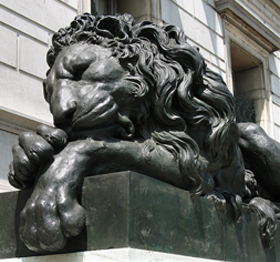By David Montgomery, The Washington Post
Historic preservationists nominated most of the graceful interior of the Corcoran Gallery of Art as a local architectural landmark Monday, a move that opens a new front in the battle over the economically struggling museum’s future.
While the Corcoran’s 1897 beaux-arts home near the White House was designated a national historic landmark in 1992, that distinction does not protect it from radical alterations by a private developer. The 68-page nomination filed by the D.C. Preservation League under the District’s preservation ordinance would require public review of significant construction work.
The city’s nine-member Historic Preservation Review Board will decide if the Corcoran’s vast atrium, grand staircase, rotunda, galleries and other critical spaces merit landmark protection, following a public hearing in the coming months. For now, the simple act of submitting the nomination blocks any construction in the historic areas, according to city preservation officials.
“Interior public spaces of this grandeur are very rare in Washington,” said Rebecca Miller, executive director of the preservation league, a membership organization founded in 1971 to save the Willard Hotel and other cherished downtown structures. Miller compared the Corcoran to Union Station, whose interior the league also recently nominated. “It’s fairly unique to have an interior that is as intact as the Corcoran is.”
The landmark proposal comes as the Corcoran’s leadership considers selling the building and moving to another location, possibly outside the city. Placing limitations on an owner’s ability to reconfigure the interior could complicate efforts to sell. Developers have previously told The Washington Post that the building would be worth more if it weren’t a historic landmark.
Now Corcoran officials find themselves in the unusual position of having to decide whether to oppose the nomination — and argue that the interior is not worthy of being landmarked — or support it and perhaps affect the market value of the building.
Mimi Carter, the Corcoran’s senior director of communications and marketing, said gallery officials had no comment.
Activists opposed to the Corcoran’s possible move hailed the preservationists’ proposal as a boost to their cause.
“My real hope is that it will give them significant pause in going ahead and selling the building,” said Roberta Faul-Zeitler, a former director of communications for the gallery who has been active with the group Save the Corcoran. “There’s no guarantee, even with landmark status, that it won’t be sold. But it probably will be a deterrent to anyone who has a notion that they can come in there and turn it into a private club or a perhaps even an embassy.”
The Corcoran’s executives have said that the gallery and the affiliated Corcoran College of Art and Design must consider relocating because it would cost an estimated $130 million to renovate the building to modern museum standards. Millions more would have to be spent to expand the college, they said. The Corcoran does not have that kind of money. Recent fundraising has lagged, and the institution posted a deficit of $7 million for the fiscal year ended in June.
No decision on whether to stay or go has been made, Carter said. And she said she had no details on potential buyers or potential new locations.
The Corcoran’s board of trustees voted last month to hire the real estate services firm CBRE to field offers and scout locations. Emanuel Fitzgerald, executive vice president with CBRE, did not return a telephone call Monday seeking comment.
Landmarked interiors are relatively rare in Washington. There are about 700 landmarked exteriors, but only 19 interiors, including Eastern Market, the Warner Theatre and the Chevy Chase Arcade, said David Maloney, the city’s historic preservation officer. The Corcoran’s exterior received local landmark status in 1964.
One reason for the disparity is that preservationists generally consider exteriors most vital to the public experience of a historic property, Maloney said. But buildings with quasi-public missions and intact interiors are good candidates for landmarking, Miller said.
The paperwork filed by the preservation league builds the case for landmarking the Corcoran’s interior on two arguments: The gallery has been tied to “events that have made a significant contribution to the broad patterns of our history,” including the rise of American art movements, the evolution of museums in the capital and gatherings of historically important figures; and the interior is architecturally distinctive, notably in how the spaces were skillfully designed to their purpose.
Faul-Zeitler, before she worked at the Corcoran, chained herself to a railing of the Old Post Office on Pennsylvania Avenue NW in the early 1970s to protect the building from demolition. She said that she notified the preservation league in June of the Corcoran’s potential move and suggested landmarking.
Miller said the league was already focusing on the Corcoran, especially following the canceled 2005 museum expansion designed by Frank Gehry. That project would have destroyed some of the historic spaces the league now seeks to protect.
The league takes no position on the Corcoran’s possible relocation, Miller said. “We are looking to safeguard this historic resource,” she said. “Whether or not the institution leaves the building is up to them. We are not an organization that dictates use, unless the use will destroy the landmark.”




